SimilarWeb Alternatives
Find your next competitive intelligence tool. We compare 10 SimilarWeb alternatives on features, data, and pricing to help you decide.

SimilarWeb is a popular tool for good reasons. Many use it for market research or to check a competitor's website traffic. It performs well when you need a quick overview of the digital landscape and want to understand broad market trends.
However, some users find the data for smaller sites can be less precise, and the cost can be a factor. For these reasons, you might seek an alternative. We analyzed the top options against SimilarWeb, using G2 reviews, to help you choose. Let's get started.
Consider 11x for Sales Automation
If your team is exploring digital workers for sales tasks, 11x provides a platform for this purpose. You can build and deploy autonomous agents for various sales-related activities, from research to outreach, which may complement your market intelligence efforts.
11x is a GTM platform that uses AI agents to manage the sales process. Its agent, Alice, finds prospects, handles outreach, and maintains the CRM. A second agent, Julian, qualifies inbound leads and books meetings. The platform combines tools for data enrichment, outreach, and email warmup, removing the need for separate solutions.
SimilarWeb Alternatives
The following section details the top alternatives to SimilarWeb. We analyze each option based on pricing, features, and its pros and cons relative to SimilarWeb.
1) Semrush

Semrush is a cloud-based suite that consolidates tools for SEO, competitive intelligence, content, and advertising. Its platform draws from a database of billions of keywords and domain profiles. Use it to benchmark site traffic, analyze competitor ad strategies, or uncover new SEO opportunities.
A 7-day free trial is available for new users to test its capabilities before commitment.
Semrush's Main Features
The platform provides tools to discover keywords from a database of 27 billion, analyze backlinks, and run technical site audits for position tracking.
It offers AI-driven features to generate SEO-ready content, find high-ranking topic ideas, and score copy in real time.
The tool analyzes how large language models feature your brand, tracks competitor AI visibility, and provides tips for improvement.
It helps optimize a Google Business Profile, manage listings in top directories, and use AI to assist with customer review responses.
Semrush vs. SimilarWeb: Key Differences
Average Review score: 4.5/5 stars based on 2,689 G2 reviews.
Semrush provides a full suite of SEO tools, including keyword research and technical site audits. This offers more depth for search optimization compared to SimilarWeb's traffic overview.
Its platform includes AI-driven features to generate SEO-ready content and score copy. This is a capability not found in SimilarWeb's core feature set.
The tool helps optimize a Google Business Profile and manage local listings. This provides a local SEO advantage not available in SimilarWeb's broader market analysis.
It analyzes a database of over 43 trillion backlinks for granular link-building insights. This dataset is more extensive for backlink analysis compared to SimilarWeb.
Semrush's Drawbacks Compared to SimilarWeb
Semrush focuses heavily on search-related data. Users who need a high-level industry overview may find SimilarWeb's broader market analysis features more suitable for that purpose.
The tool provides less detailed audience demographic data. In contrast, SimilarWeb offers more granular insights into a website's audience, including age, gender, and user interests.
It has an extensive feature set, which sometimes presents a learning curve. For users who only need a quick traffic estimate, SimilarWeb's interface can be more straightforward.
Budget and Pricing Considerations
Semrush offers public pricing tiers, starting at $139.94 per month for its Pro plan and $249.95 for its Guru plan. In contrast, SimilarWeb’s pricing is typically customized and requires a sales consultation, making a direct comparison for entry-level packages challenging.
2) Ahrefs
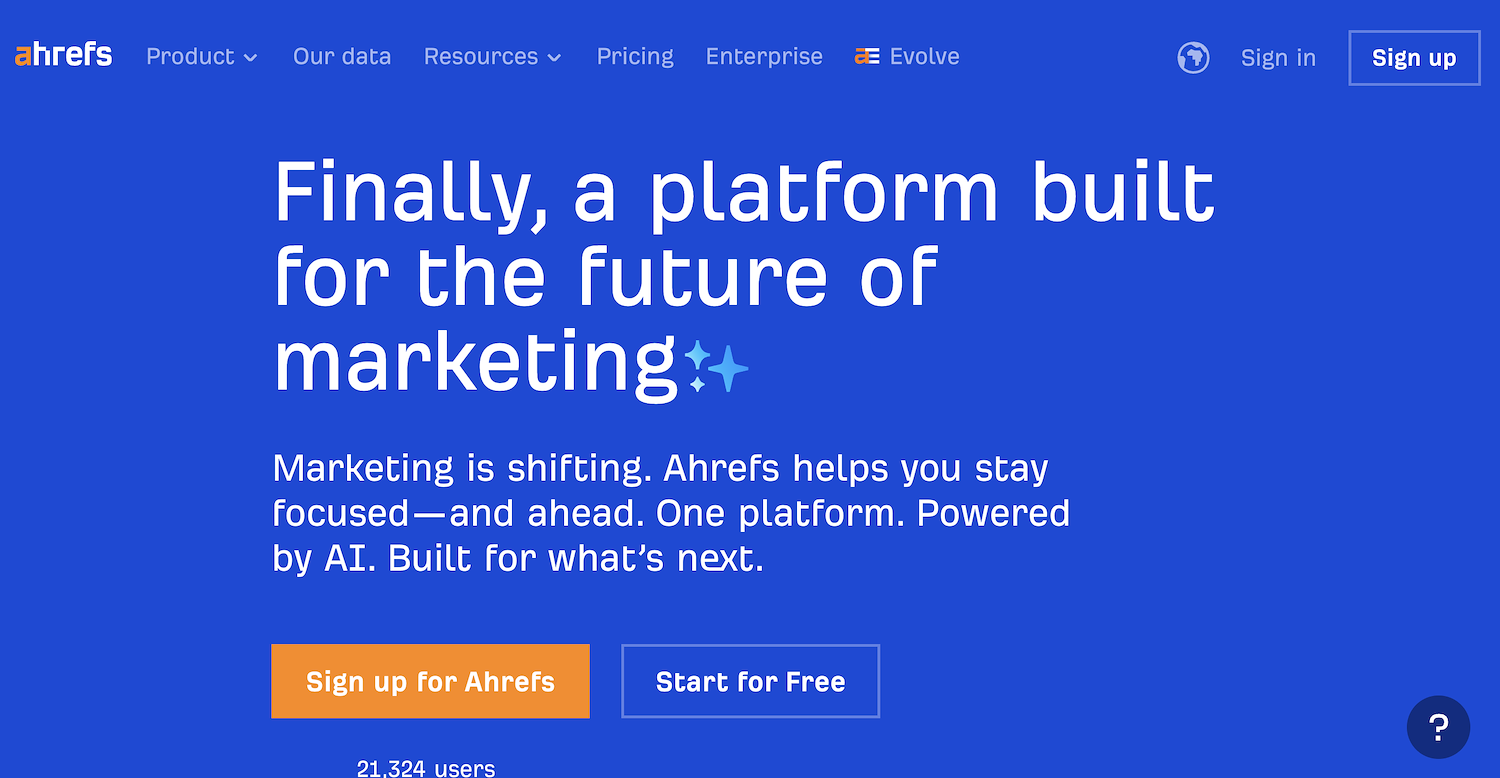
Ahrefs consolidates SEO, content, and paid-search tools. It uses AI to automate research for market intelligence. Users can track competitor market positions, market shifts, and share-of-voice to inform go-to-market strategies. The platform draws data from its proprietary SEO crawler.
Ahrefs's Main Features
Generates, localizes, and evaluates content quality with an AI helper and grader.
Monitors website health with 24/7 site audits and automates technical fixes via Patches.
Optimizes and monitors Google Business Profiles for local pack and map results.
Tracks brand mentions, citations, and sentiment across AI chatbots and search engines.
Ahrefs vs. SimilarWeb: Key Differences
Average Review score: 4.5/5 stars based on 583 G2 reviews.
Ahrefs provides a more detailed backlink analysis, drawing from an index of over 35 trillion backlinks. This offers deeper insights for link-building strategies compared to SimilarWeb's broader traffic overview.
Its web crawler is the most active in the SEO industry, which can result in fresher data for site audits. This is different from SimilarWeb, which focuses more on aggregated market-level traffic data.
The tool offers a keyword database of over 110 billion keywords. This provides more granular data for SEO campaigns, a feature set more extensive than SimilarWeb's traffic source analysis.
The platform includes a comprehensive site audit tool that monitors website health and helps automate technical fixes. This internal optimization feature is not a primary focus of SimilarWeb, which concentrates on external competitive intelligence.
Ahrefs's Drawbacks Compared to SimilarWeb
Ahrefs offers less granular audience demographic data. In contrast, SimilarWeb provides deeper insights into a website's audience, such as age and gender, which helps with persona creation.
The tool focuses heavily on search-related metrics. Users who require a high-level industry overview might find SimilarWeb's broader market analysis more aligned with their needs.
Some users report that the extensive feature set creates a learning curve. For a quick traffic estimate, SimilarWeb's interface can be more straightforward to navigate.
Budget and Pricing Considerations
Ahrefs uses a transparent pricing model, with its Lite plan starting at $129 per month. Unlike SimilarWeb, which requires a sales call for a custom quote, Ahrefs provides clear entry points for smaller budgets. You can see all tiers on Ahrefs's official website.
3) Moz Pro
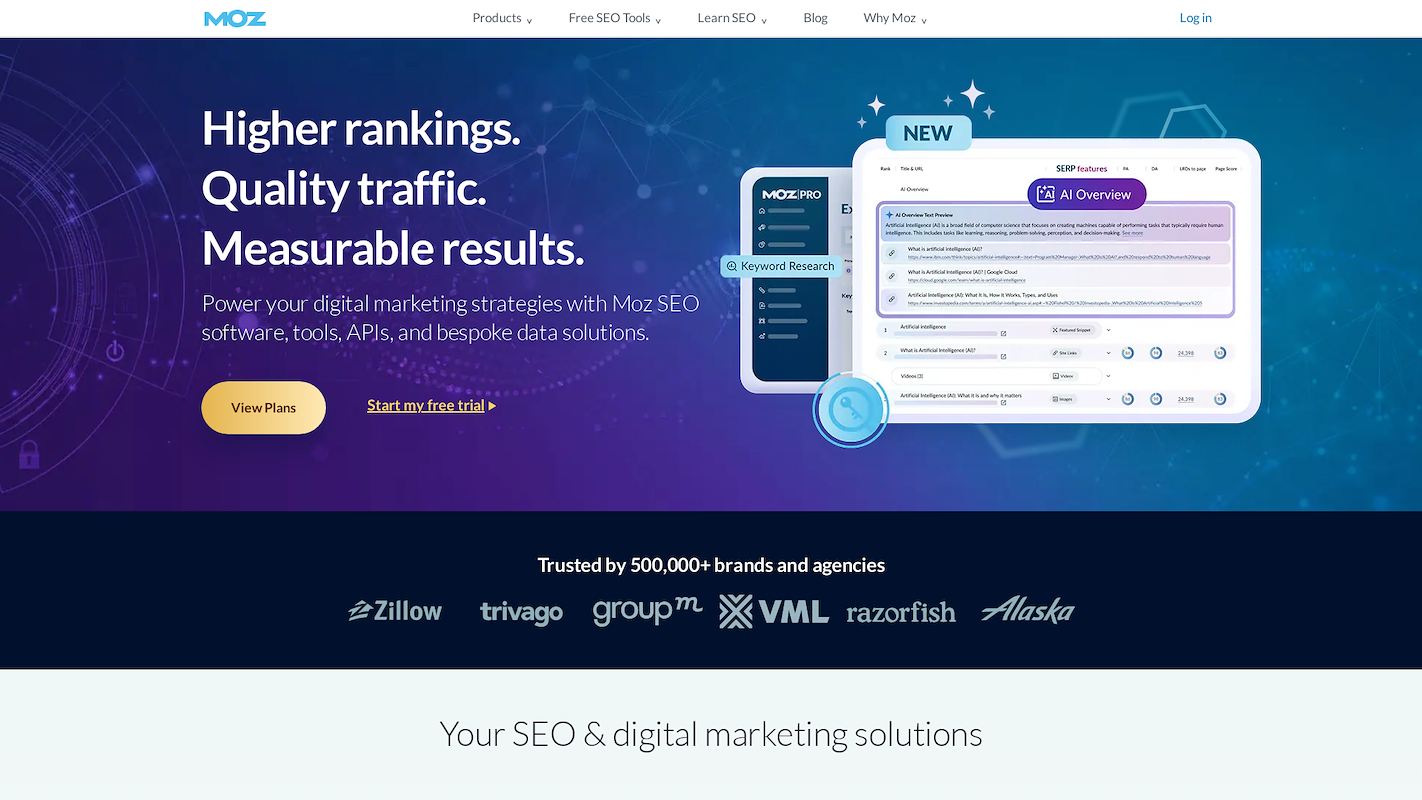
Moz Pro is an SEO platform that helps marketers attract traffic and generate leads. It combines keyword research, site audits, competitive analysis, and rank tracking into a single dashboard. The tool provides AI-powered insights to support SEO goals.
Use cases include keyword discovery, website audits, and rank monitoring. You can also benchmark against competitors, fix technical errors, and build custom reports for clients or stakeholders.
Moz Pro's Main Features
Provides keyword metrics, including search volume and difficulty, and uses AI to group suggestions by search intent.
Conducts deep technical audits to find site errors and provides prioritized reports for fixes.
Offers page-specific recommendations to improve search rankings and traffic for individual pages.
Monitors keyword ranking positions across various search engines, countries, and specific locations.
Moz Pro vs. SimilarWeb: Key Differences
Average Review score: 4.3/5 stars based on 569 G2 reviews.
Moz Pro provides deep keyword research tools with AI-driven intent grouping. This offers more specific data for SEO strategy than SimilarWeb's focus on traffic-driving keywords.
It conducts technical site audits to find and prioritize errors. This is a different function from SimilarWeb, which analyzes external market and traffic data rather than internal site health.
The tool offers specific on-page optimization recommendations to improve search rankings. In comparison, SimilarWeb reports on page-level traffic but does not provide direct SEO advice for those pages.
Its platform includes dedicated link-building tools to support outreach efforts. SimilarWeb shows referring domains as a traffic source but lacks the specialized features for active link acquisition campaigns.
Moz Pro's Drawbacks Compared to SimilarWeb
Moz Pro provides limited audience demographic data. In contrast, SimilarWeb offers more detailed insights into a site's audience, such as user age, gender, and interests, which helps with persona development.
The tool centers on SEO-specific metrics. Users who need a broad overview of market-wide trends may find SimilarWeb's industry analysis features more aligned with their requirements.
Its data on traffic sources sometimes focuses more on search. SimilarWeb, on the other hand, typically provides a more complete breakdown of all traffic channels, including direct, referral, and social media.
Budget and Pricing Considerations
Moz Pro offers transparent pricing, with its Standard plan at $99 per month. This contrasts with SimilarWeb, which requires a sales consultation for a custom quote, making Moz Pro more accessible for teams needing predictable costs. For detailed pricing, visit Moz Pro's official website.
4) SE Ranking

SE Ranking is an SEO software suite with tools for competitor analysis, keyword research, and website audits. Businesses use the platform to track search engine rankings and monitor competitor activities online. This data helps identify market opportunities and supports sales intelligence efforts.
SE Ranking's Main Features
Tracks brand visibility in AI-generated answers from Google, ChatGPT, Gemini, and Perplexity.
Provides white-label software with a custom domain, branding, and a lead generator widget for agency websites.
Includes a content editor that offers AI-powered tips to optimize existing pages.
Manages local business listings and tracks rankings in local pack and map results.
SE Ranking vs. SimilarWeb: Key Differences
Average Review score: 4.8/5 stars based on 3,170 G2 reviews.
SE Ranking tracks brand visibility in AI-generated answers. This offers a view into emerging search channels that SimilarWeb's traditional traffic analysis does not cover.
The tool offers white-label options for agencies to use the software under their own brand. SimilarWeb, in contrast, operates as a branded platform without this customization for resellers.
It includes a content editor with AI-powered tips for on-page optimization. This is a feature for content creation, which differs from SimilarWeb's focus on external traffic metrics.
Its platform helps manage local business listings and track map rankings. This offers a more granular view of local search performance compared to SimilarWeb's country-level traffic data.
SE Ranking's Drawbacks Compared to SimilarWeb
SE Ranking provides limited data on audience demographics. In contrast, SimilarWeb offers deeper insights into user age, gender, and interests, which helps create detailed customer personas.
The tool centers on search-related metrics. Users who need a broad overview of an entire industry may find SimilarWeb's market analysis features more suitable for high-level strategic planning.
Its analysis of traffic sources sometimes focuses more on search. SimilarWeb, on the other hand, typically provides a more complete breakdown of all traffic channels, including direct, referral, and social media.
Budget and Pricing Considerations
SE Ranking offers transparent pricing plans, which contrasts with SimilarWeb's custom-quote model that requires a sales consultation. This makes SE Ranking's costs more predictable for budget planning. You can find detailed pricing on SE Ranking's official website.
5) Serpstat

Serpstat is a software platform for marketing and sales teams. It offers tools for market and competitive analysis. Businesses use its data to find opportunities, track competitors, and inform sales strategy. The platform provides information that can act as sales triggers and support sales intelligence.
Serpstat's Main Features
Conducts automated technical SEO audits and provides prioritized issue lists with actionable recommendations.
Groups keywords by topical similarity to help build structured website semantics for content planning.
Monitors desktop and mobile keyword rankings in any Google locale and offers free project migration from other tools.
Provides API access to its database with a dedicated integration team and terms that permit data reselling.
Serpstat vs. SimilarWeb: Key Differences
Average Review score: 4.6/5 stars based on 462 G2 reviews.
Serpstat conducts automated technical SEO audits and provides prioritized issue lists. This differs from SimilarWeb, which focuses on external market data rather than a website's internal health.
It groups keywords by topical similarity to help build a structured website for content planning. In comparison, SimilarWeb reports on traffic-driving keywords but does not offer this type of semantic organization.
The tool provides API access with terms that permit data reselling. This offers a business model for agencies that is not a standard feature in SimilarWeb's platform.
Serpstat offers free project migration from other SEO tools. This feature supports teams that switch platforms, a service not highlighted by SimilarWeb.
Serpstat's Drawbacks Compared to SimilarWeb
Serpstat provides limited data on audience demographics. In contrast, SimilarWeb offers deeper insights into user age and gender, which helps teams create more detailed customer personas.
The tool centers on search-related metrics. For a broad overview of an entire industry, some users may find SimilarWeb's market analysis features more suitable for high-level planning.
Its analysis of traffic sources can sometimes focus more on search. SimilarWeb typically provides a more complete breakdown of all channels, including direct, referral, and social media traffic.
Budget and Pricing Considerations
Serpstat offers transparent pricing, with its Individual plan starting at $69 per month. This contrasts with SimilarWeb's custom-quote model, making Serpstat's costs more predictable for budget planning. For detailed pricing, visit Serpstat's official website.
Try 11x for Sales Automation
For sales process automation, explore what 11x offers. The platform uses digital workers for prospect research, outreach, and lead qualification. This can support your market intelligence efforts and automate parts of your go-to-market plan.
With 11x, we use AI to operate your sales playbook. Our agent Alice finds accounts, enriches their data, and conducts outreach. Julian qualifies prospects and books meetings. The platform combines data, outreach, and warmup tools, replacing other parts of your GTM stack.
Book a demo to see the platform in action.
6) Ubersuggest
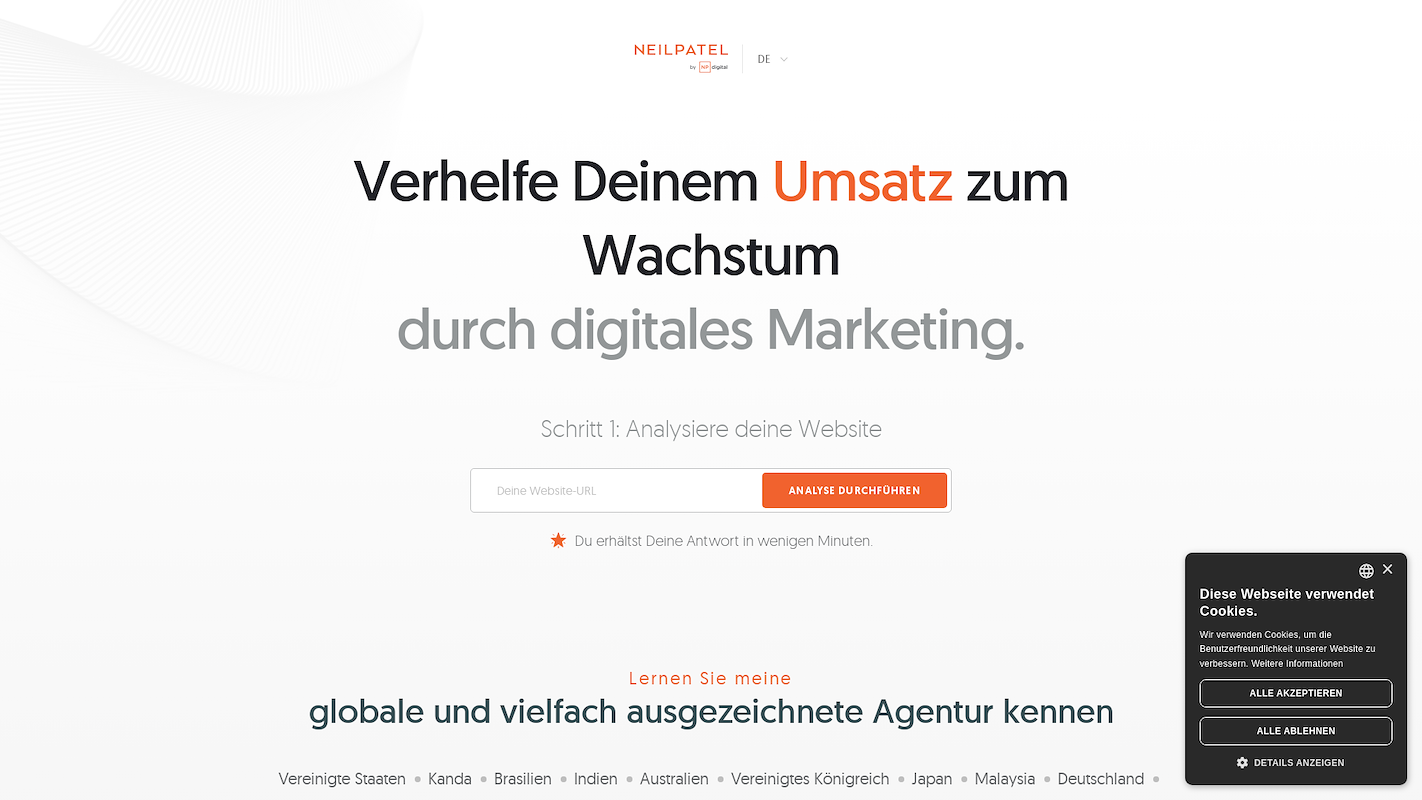
Ubersuggest is an SEO tool for keyword discovery and competitive intelligence. It provides data on keywords, content ideas, and backlink profiles. Businesses use the platform to find market opportunities, analyze competitor strategies, and inform sales intelligence efforts.
Ubersuggest's Main Features
It identifies competitor pages that rank for popular keywords and attract significant social engagement.
The tool generates head and long-tail keyword ideas with data on search volume, competition, and seasonal trends.
It surfaces the most shared and linked-to content for a given keyword to inform topic strategy.
The platform reveals the exact content and domains that link to competitors to support outreach campaigns.
Ubersuggest vs. SimilarWeb: Key Differences
Average Review score: 4.2/5 stars based on 142 G2 reviews.
Ubersuggest identifies competitor pages that rank for popular keywords and also have high social engagement. This combines SEO and social data, which is different from SimilarWeb's traffic-focused page analysis.
It generates long-tail keyword ideas with data on search volume and seasonal trends. This offers more detail for keyword planning compared to SimilarWeb's list of a site's top keywords.
The tool reveals the specific content that links to competitors. This provides direct information for link-building outreach, a more granular approach than SimilarWeb's list of referring domains.
Its platform includes a site audit feature to find and fix technical SEO problems. This function for internal website health is not part of SimilarWeb's external market analysis.
Ubersuggest's Drawbacks Compared to SimilarWeb
Ubersuggest offers less detail on audience demographics. In comparison, SimilarWeb provides specific data on user age and gender, which is useful for creating detailed customer personas.
Some users may find its market analysis less comprehensive. SimilarWeb, for instance, provides a broader overview of industry-wide trends, while Ubersuggest centers more on search-specific data.
The tool's analysis of traffic sources tends to focus on search. In contrast, SimilarWeb usually offers a more complete breakdown of all channels, such as direct, referral, and social media traffic.
Budget and Pricing Considerations
Ubersuggest offers transparent pricing with monthly and lifetime plans, which contrasts with SimilarWeb's custom-quote model, making it a more predictable option for budget planning. You can find detailed pricing on Ubersuggest's official website.
7) SpyFu
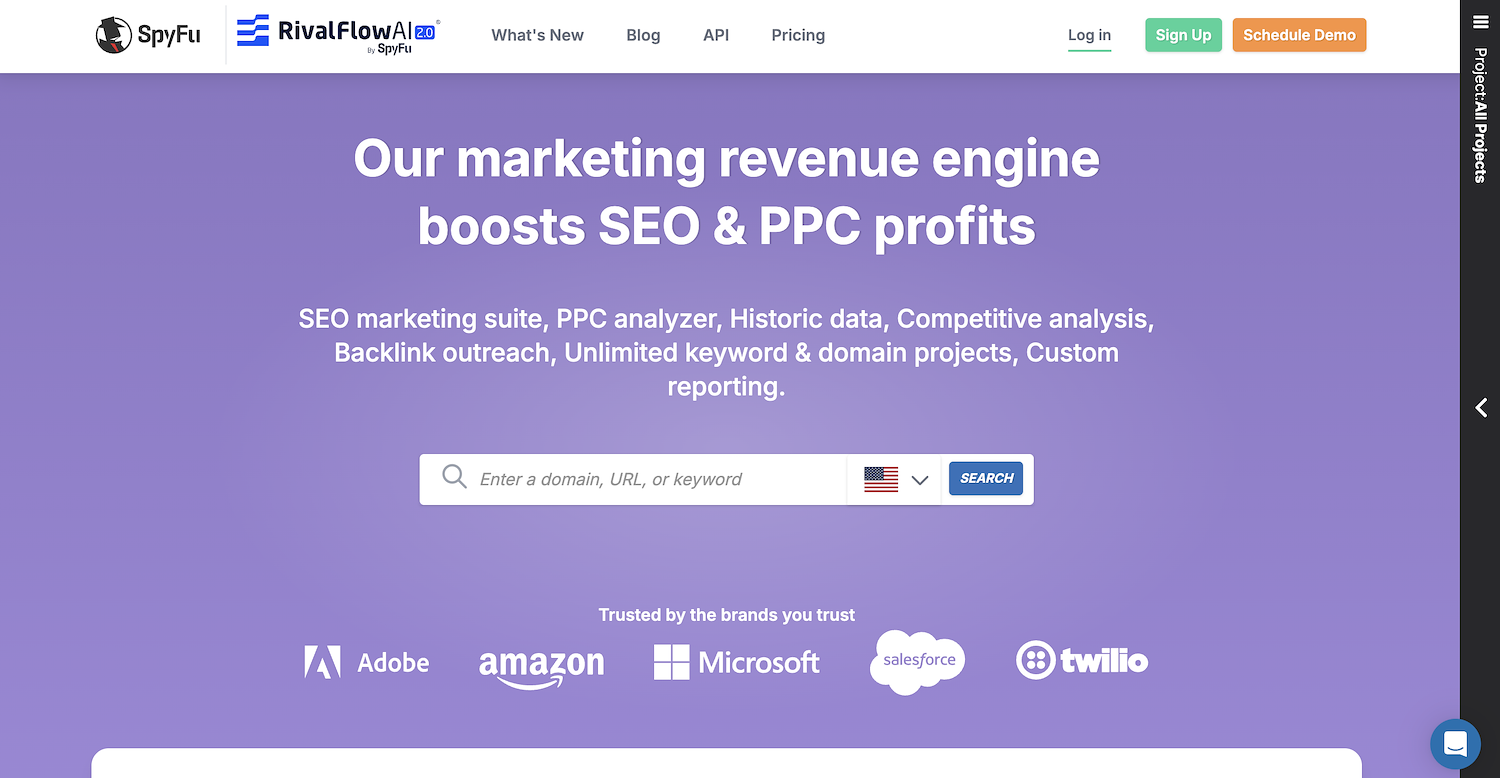
SpyFu is a competitive intelligence tool for sales and marketing. It shows the search marketing strategies of competitors. You can see every keyword they rank on, every ad they run, and every ad variation from the last 18 years.
This data helps identify market shifts and informs sales strategy. The platform focuses on PPC and SEO data to find new leads and track competitor moves.
SpyFu's Main Features
It provides access to a 14-year archive of ranking data, ads, keywords, and backlinks for any domain.
The platform uncovers competitor Google Ads keywords and provides buy-keyword recommendations and negative-match suggestions.
Its RivalFlow AI scans for content gaps and produces articles to fill them.
The tool generates white-label reports with options for scheduled and automated delivery.
SpyFu vs. SimilarWeb: Key Differences
Average Review score: 4.6/5 stars based on 513 G2 reviews.
SpyFu provides access to a 14-year archive of ranking and ad data, which offers a more extensive view of long-term search marketing changes than SimilarWeb's trend analysis.
The platform uncovers competitor Google Ads keywords and provides buy recommendations. This offers more specific data for PPC campaign planning compared to SimilarWeb's overview of paid search traffic.
Its RivalFlow AI scans for content gaps and produces articles to fill them. This content generation feature is not present in SimilarWeb, which focuses on traffic and market analysis.
The tool generates white-label reports with options for automated delivery. This customization for agencies is a feature not offered by SimilarWeb, which operates as a branded platform.
SpyFu's Drawbacks Compared to SimilarWeb
SpyFu provides limited data on audience demographics. In contrast, SimilarWeb offers more granular insights into a site's audience, including age and gender, which is useful for detailed persona development.
The tool's focus is on search-specific metrics. For a broad overview of an entire industry, some users may find SimilarWeb's market analysis features more aligned with high-level strategic planning.
Its analysis of traffic sources sometimes centers more on search. SimilarWeb, in contrast, usually provides a more complete breakdown of all traffic channels, including direct, referral, and social media.
Budget and Pricing Considerations
SpyFu offers transparent pricing, with plans starting at $39 per month, which contrasts with SimilarWeb's custom-quote model. This makes SpyFu's costs more predictable for budget planning. For detailed pricing, visit SpyFu's official website.
8) Quantcast Measure
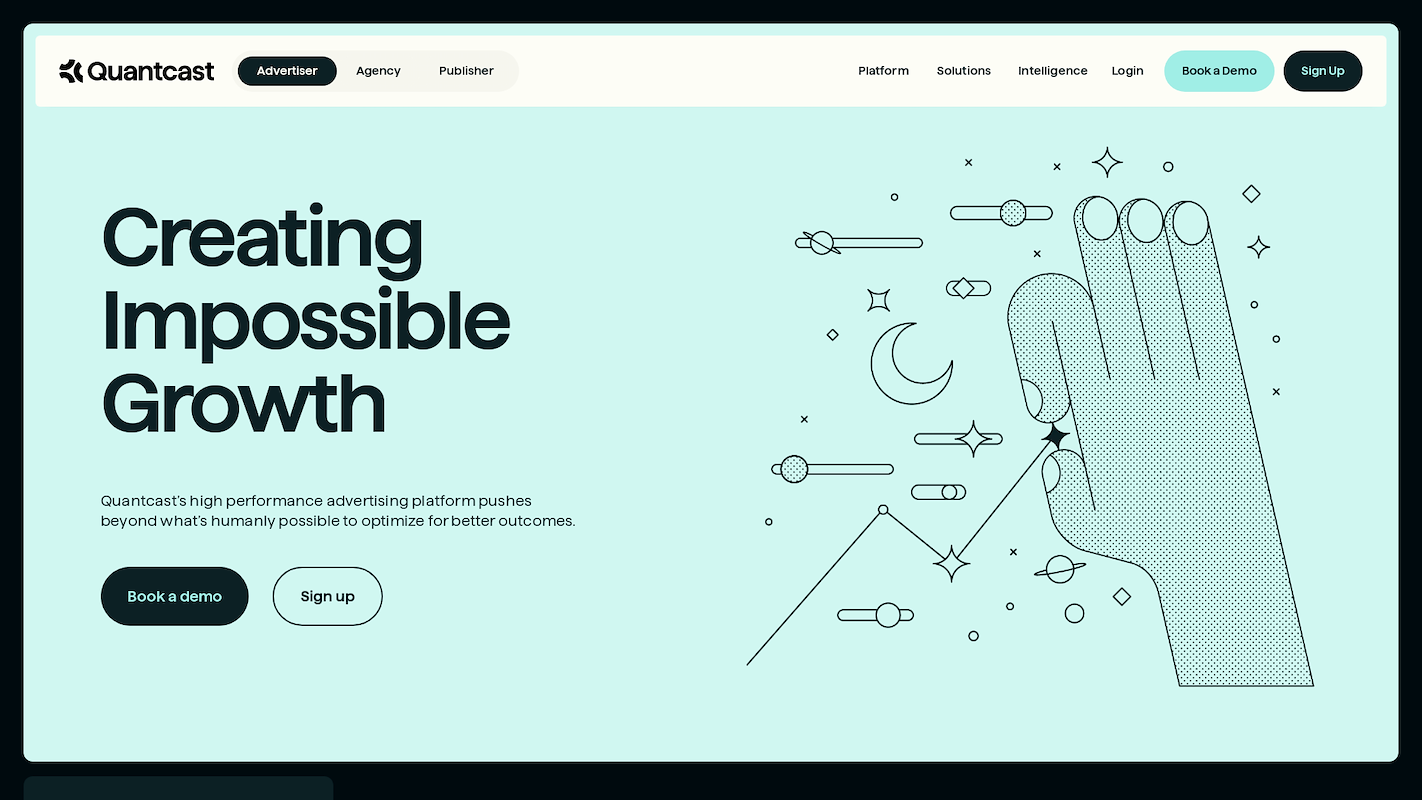
Quantcast Measure is a tool for direct audience measurement. It uses a tag on a website to collect first-party data on visitor demographics and interests. This method provides an accurate view of a site's audience, unlike platforms that rely on estimation.
For sales intelligence, this data can show the customer profile of a prospect that uses the service. Quantcast Measure is available at no cost to publishers and site owners.
Quantcast Measure's Main Features
Provides tools for campaign management and optimization through a dedicated dashboard.
Offers audience targeting capabilities, including options for retargeting and geo-targeting.
Generates custom reports to measure campaign performance and reliability.
Quantcast Measure vs. SimilarWeb: Key Differences
Average Review score: 4.2/5 stars based on 140 G2 reviews.
Quantcast Measure collects direct, first-party audience data through a site tag. This method offers a more precise view of visitors than SimilarWeb's data estimation models.
The platform includes tools for campaign management and optimization. Users can act on audience insights directly, a function different from SimilarWeb's focus on market analysis.
This tool provides specific audience targeting options like retargeting and geo-targeting. It gives more granular control for ad campaigns compared to the broader audience overview found in SimilarWeb.
It generates custom reports to measure campaign performance and reliability. This focus on advertising ROI is different from SimilarWeb, which reports on general website traffic and engagement metrics.
Quantcast Measure is available at no cost for publishers and site owners. This is a significant difference from SimilarWeb, which operates on a paid subscription model with custom pricing.
Quantcast Measure's Drawbacks Compared to SimilarWeb
Quantcast Measure provides audience data only for sites where its tag is installed. In contrast, SimilarWeb offers traffic and engagement metrics for almost any public website without requiring site access.
The tool does not offer competitive keyword analysis. SimilarWeb, on the other hand, shows the top organic and paid keywords that drive traffic to competitor sites, which helps in SEO and PPC planning.
Some users may find its market analysis limited. SimilarWeb provides a broad overview of industry-wide trends, while Quantcast Measure centers on the audience of a single property.
Its platform does not provide a detailed breakdown of a competitor's traffic sources. In comparison, SimilarWeb shows a complete picture of traffic channels, including direct, referral, and social media.
Budget and Pricing Considerations
Quantcast Measure is available at no cost for publishers and site owners. This is a key difference from SimilarWeb, which operates on a paid subscription model and requires a sales consultation for a custom quote.
9) data.ai
data.ai, formerly App Annie, is a market intelligence platform focused on the mobile ecosystem. It provides data on app performance, including downloads, revenue, and user engagement. Businesses use it to track competitors and identify trends in the mobile market.
data.ai's Main Features
The platform offers app-level analytics for downloads, revenue, and usage metrics across major app stores.
It provides tools for App Store Optimization (ASO) to improve visibility and conversion rates.
Users can access market data reports and forecasts to understand the broader mobile economy.
It tracks mobile ad performance across various networks to help optimize advertising spend.
data.ai vs. SimilarWeb: Key Differences
Average Review score: 4.5/5 stars based on 238 G2 reviews.
data.ai specializes in mobile app intelligence. This provides deeper insights into app performance than SimilarWeb, which has a primary focus on website traffic analysis.
The platform includes dedicated App Store Optimization (ASO) tools. This helps improve an app's visibility in stores, a feature not central to SimilarWeb's offering.
It offers detailed mobile advertising analytics. This gives users granular data on ad spend, a different approach from SimilarWeb's broad overview of traffic sources.
data.ai provides market forecasts specific to the mobile economy. This is a more focused analysis than SimilarWeb's industry-level web traffic trends.
data.ai's Drawbacks Compared to SimilarWeb
The platform's web analytics capabilities are less comprehensive. Teams that need detailed website traffic data may find SimilarWeb's feature set more suitable for that purpose.
Its focus is on the mobile market. For a complete view of a company's digital footprint across both web and mobile, users might need to combine it with another tool.
Some users report that the interface can be complex. For quick high-level metrics, SimilarWeb's dashboard may feel more direct to navigate.
Budget and Pricing Considerations
data.ai's pricing is not publicly listed and requires a sales consultation for a custom quote. This model is similar to SimilarWeb, which also tailors its plans for enterprise clients, making a direct cost comparison difficult without a demo.
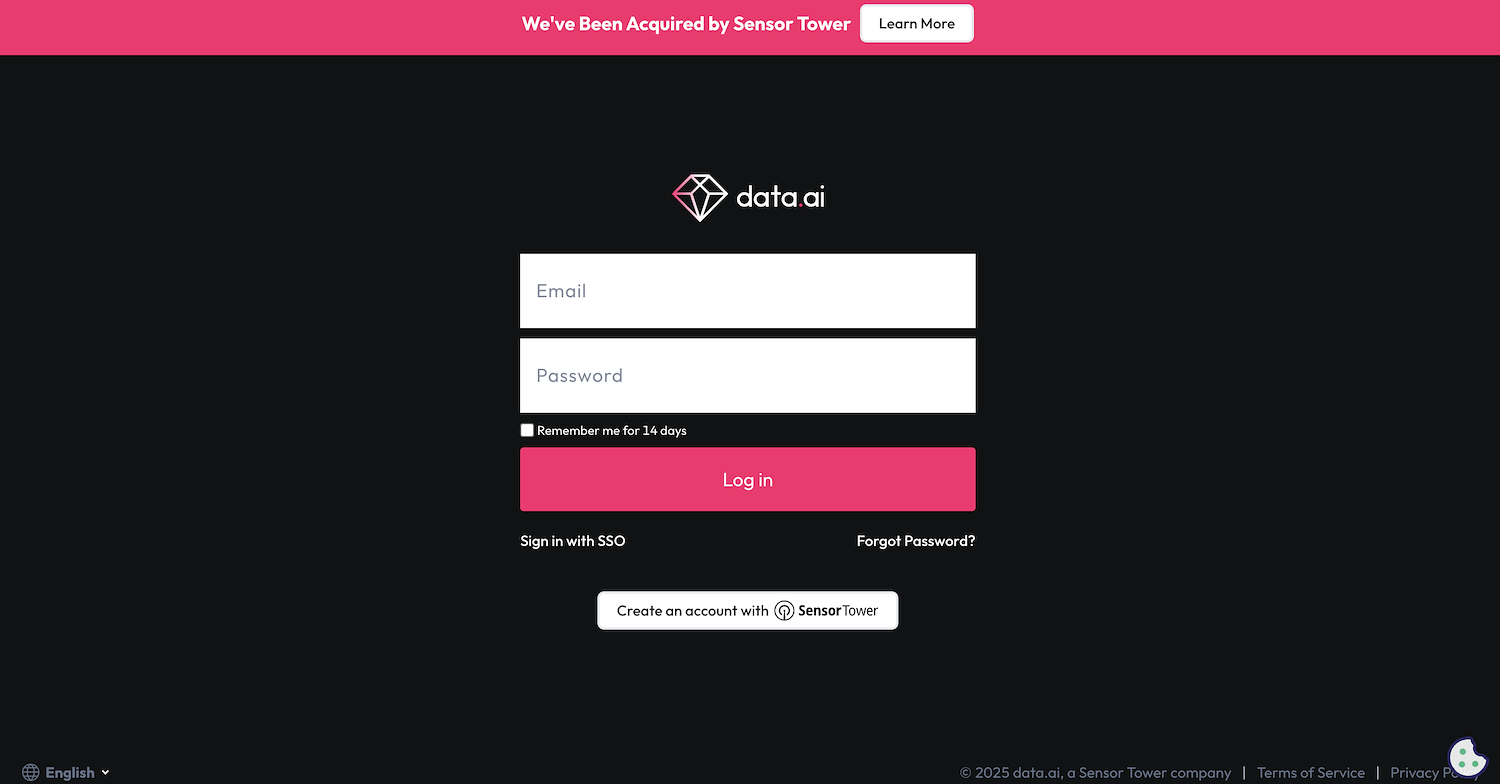
data.ai, formerly App Annie, is a market intelligence platform for the mobile ecosystem. It offers data on app performance, such as downloads and revenue. For sales intelligence, teams use this to track competitors and spot trends, which can signal sales opportunities in the mobile market.
data.ai's Main Features
Offers an advertising analytics solution that provides a side-by-side view of market insights and a company's own data.
Provides data on how app usage differs across more than 60 countries.
Includes tools to benchmark mobile performance against competitors.
Helps improve app ratings and user retention.
data.ai vs. SimilarWeb: Key Differences
Average Review score: 4.3/5 stars based on 94 G2 reviews.
data.ai provides tools to benchmark mobile performance against competitors. This offers a more focused comparison for app developers than SimilarWeb's broader website-centric benchmarks.
It offers an advertising analytics solution that combines market insights with a company's own data. This is different from SimilarWeb, which primarily reports on external traffic sources and does not integrate internal performance data.
The tool shows how app usage varies in more than 60 countries. This gives a more granular, country-specific view of mobile behavior compared to SimilarWeb's regional or global web traffic data.
Its platform includes features to help improve app ratings and user retention. This is a specific function for app lifecycle management, which is not a core part of SimilarWeb's competitive web analysis.
data.ai's Drawbacks Compared to SimilarWeb
data.ai centers on mobile app data, so its web analytics are less detailed. In contrast, SimilarWeb offers a complete view of website traffic sources and audience engagement, which some users may find more useful for broad market research.
Its competitive intelligence tools are built for the mobile ecosystem. For a full picture of a competitor's digital strategy across both web and mobile, users might need another tool, unlike SimilarWeb which covers web performance extensively.
The platform lacks detailed web keyword analysis for SEO and PPC. SimilarWeb shows the top organic and paid keywords that drive traffic to websites, a feature data.ai does not provide for web properties.
Budget and Pricing Considerations
data.ai's pricing is not publicly listed and requires a sales consultation for a custom quote. This model is similar to SimilarWeb, which also tailors its plans for enterprise clients, making a direct cost comparison difficult without a demo.
10) Comscore
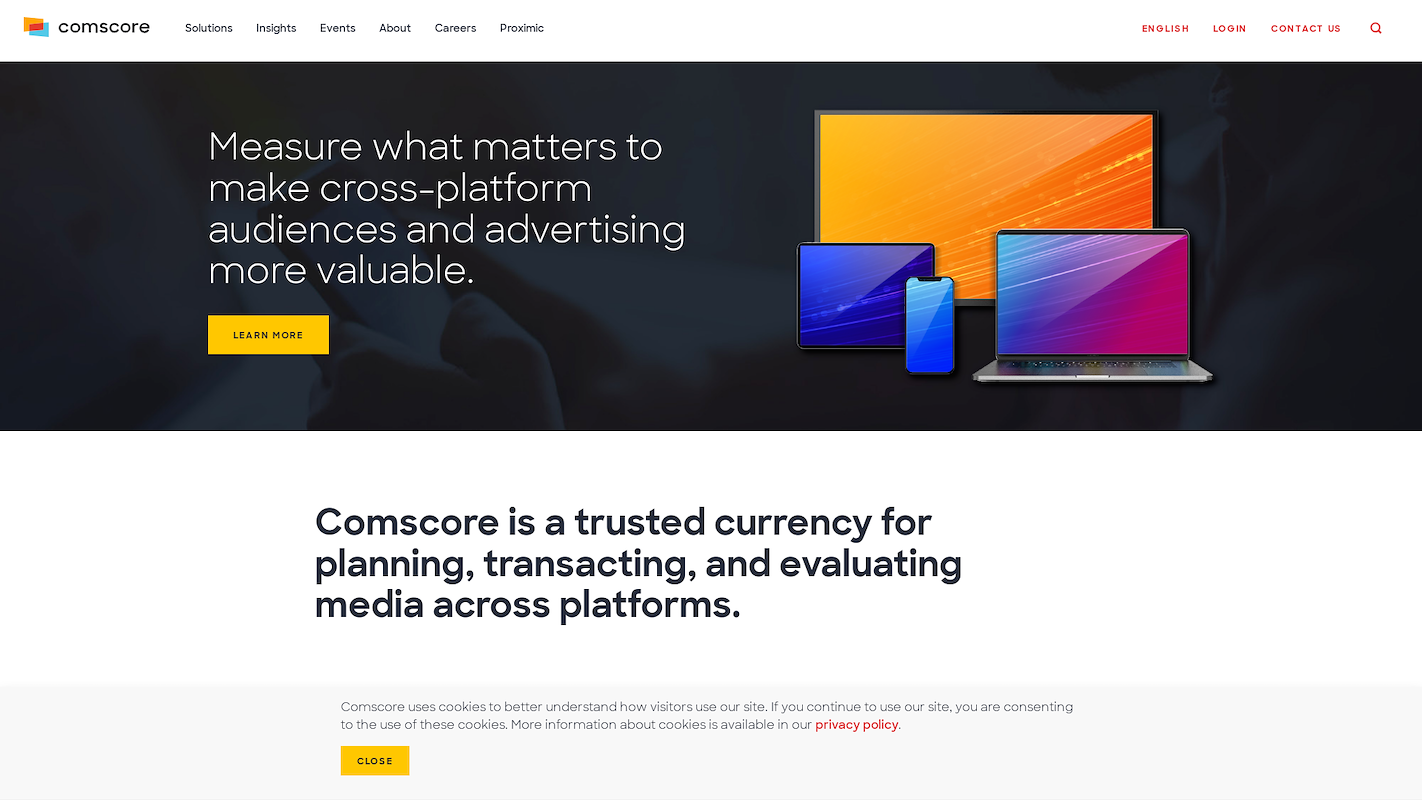
Comscore is a media measurement and analytics company that provides data on audiences across digital, TV, and film. Businesses use this information to understand consumer behavior and media consumption patterns.
For sales intelligence, the data reveals shifts in competitor media spend or audience engagement. These changes can act as sales triggers and highlight market opportunities.
Comscore's Main Features
Offers real-time, trending, and retroactive reporting for media analysis.
Monitors internal site performance with site search reporting and load time tracking.
Measures digital analytics metrics such as sessions, engagement, and entry and exit pages.
Includes user, role, and access management for administrative control.
Comscore vs. SimilarWeb: Key Differences
Average Review score: 4.1/5 stars based on 72 G2 reviews.
Comscore measures audiences across digital, linear TV, and film. This provides a broader view of media consumption compared to SimilarWeb's focus on web and mobile app analytics.
It monitors internal site performance metrics, including site search and page load times. This function supports website optimization, which differs from SimilarWeb's external competitive analysis.
The tool offers retroactive reporting for historical media analysis. This allows for a different type of trend investigation than the standard time-range views in SimilarWeb.
Its platform includes detailed user, role, and access management. This provides more administrative control for large teams than the typical user management options in SimilarWeb.
Comscore's Drawbacks Compared to SimilarWeb
Comscore offers limited data on the specific keywords that drive traffic to competitors. In contrast, SimilarWeb provides a detailed list of top organic and paid keywords, which is useful for SEO and PPC analysis.
The platform may not provide a granular breakdown of a competitor's traffic channels. Users who need to see the exact mix of direct, referral, and social traffic might find SimilarWeb's channel overview more detailed for this purpose.
Some users report that the platform's interface can be complex to navigate. For teams that need quick, high-level traffic estimates, SimilarWeb's dashboard may be more straightforward.
Budget and Pricing Considerations
Comscore's pricing is not publicly listed and requires a sales consultation for a custom quote. This model is similar to SimilarWeb, which also tailors its plans for enterprise clients, making a direct cost comparison difficult without a demo.
Which One Should You Go With?
Choosing a SimilarWeb alternative involves many variables, from budget to specific use cases. This guide analyzed the top options to help you find the right fit for your team's market intelligence needs.
If your goal extends beyond market research to sales automation, consider 11x. The platform uses digital workers for prospect research, outreach, and lead qualification, which can support your market intelligence efforts and automate parts of your go-to-market plan.




